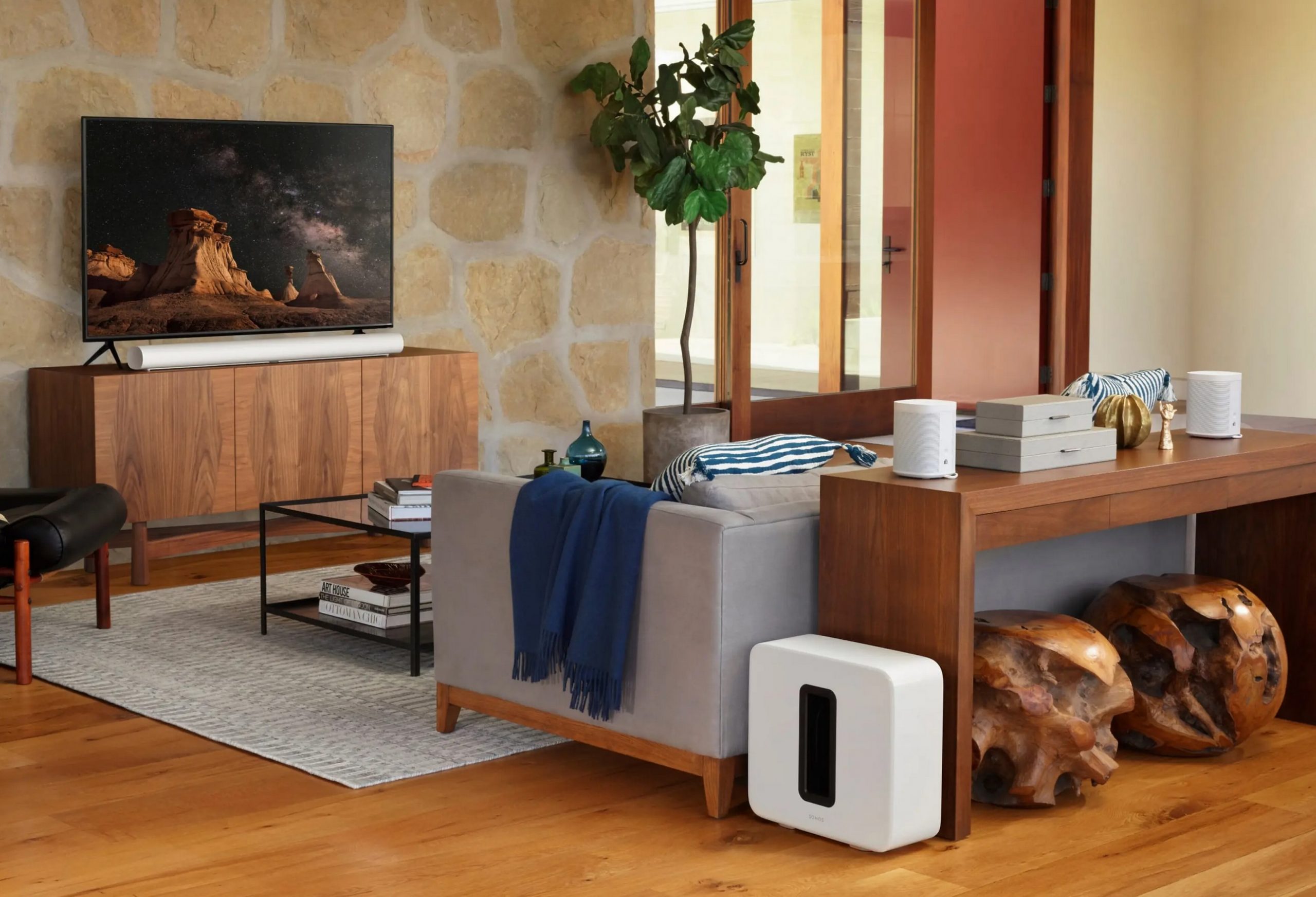The Sonos Arc is a premium soundbar for 5.0.2 Dolby Atmos/DTS:X and up to 5.1 Dolby Digital surround sound. Is it often bought by Sonos enthusiasts because of its outstanding multiroom audio features.
We first saw the Sonos Arc back in mid-2020, and like most Sonos products, it is still current. If anything it has improved via updates to its S2 App. Why the review revisit?
We wanted to ensure that most of the products mentioned in How to buy a soundbar that meets your needs? (guide) were up to date.
The Arc has a bright sound (clear), and its expandable via the Sonos Sub and (5.1.2) and a pair of Sonos One SL (or Fives) to reinforce surround sound.
Our findings: An excellent standalone all-in-one 5.0.2 Dolby Atmos/DTS:X and 5.0 surround soundbar provides superior sound and an expansive sound stage.
Sonos Arc 7.0 Dolby Atmos with optional Sub and surrounds
| Website | Sonos Website here Arc here Sub here One SL here Product guides here |
| Price | Arc $1499 Sub $1099 Pair One SL $578 Package with Sub and 2 x One SL rears $3176 |
| From | Sonos Online with free shipping and a 100-day moneyback guarantee Harvey Norman, JB Hi-Fi, Good Guys, Addicted to Audio, Videopro, and selected Hi-Fi specialists |
| Warranty | 24-months ACL compliant |
| Country of manufacture | China |
| Company | Sonos is an American Audio company based in Santa Barbara, California. It was founded in 2002 and develops and manufactures smart speakers |
| More | CyberShack Sonos news and reviews |



First impression – heavy
At least that is what the courier said when he lugged the Arc, Sub and One SLs up the stairs. Well, thankfully, about half that is Sonos’s beautiful protective packaging. The Arc is 1141.7 x 115.7 x 87mm x 6.25kg, the Sub is 389 x 158 x 402 mm x 16kg and the One SLs are 161.45 x 119.7mm square x 1.85kg each.
The second impression is evident craftsmanship as in all Sonos products.
We are reviewing the soundbar both as an all-in-one 5.0.2 and with the optional Sub and One SL rears (5.1.2)
Let’s explain Sonos Arc implementation of Dolby Atmos (DA)
It is a 7 audio channel soundbar featuring 11 speakers and 11 Class D power amps.
- Left front-firing stereo
- Right front-firing stereo
- Centre front-firing for clear dialogue
- Centre front-firing tweeter *
- Left side-angle-firing tweeter *
- Right side-angle-firing tweeter *
- Left side-firing rear surround
- Right side-firing rear surround
- Left up-firing Dolby Atmos
- Right up-firing Dolby Atmos
* Tweeters are not part of the speaker numbering system as they take over the mid-and-high treble from the 5.0 speakers 1, 2, and 3.

Because it has two up-firing speakers, Dolby Atmos (DA) sees it as 5.0.2, and if you add a Sub, it is 5.1.2 – in my opinion, that is all you need for movies at home.
If you are not playing DA, the speaker is seen as up to 5.0/5.1 by PCM and surround sound formats.
Sub specs
The Sub reinforces low-bass from 25Hz (excellent) via two D-class amps. Depending on your speakers ‘ frequency range, you can adjust the crossover (to other Sonos speakers) from 50-110Hz (80Hz default). Remember, the Sub is to be felt rather than heard.
It has Two force-cancelling speakers positioned face-to-face for deeper, richer sound and zero cabinet buzz or rattle. The highly polished piano black (or white) Sub is a design masterpiece. The Sub can also connect to most other Sonos speakers, and it has Wi-Fi and an Ethernet port.
Sonos One SL specs (SL means no voice assistant)
Each has 2 D-class amps and a forward-firing tweeter and mid-woofer. These are hi-fi quality capable of stereo pairing if not used as rears for the Arc.

Setup – Sonos S2 App is foolproof
Plug-in 240V power and the HDMI eARC/ARC cable from the TV. You can also use it with the $39 Optical Out-to-HDMI adapter (does not support DA).
If your TV supports Dolby Vision and DA, the Sonos Arc will decode that metadata and phase it across all 11 speakers.
The Sonos App for Android and iOS is foolproof. If it does not work, its more to do with your Wi-Fi setup. Make sure the smartphone is on a 2.4Ghz Wi-Fi band.
Assuming you don’t have Sonos already (and this is the start of your multi-room adventure), open the App and create a Sonos account.
The App will then find the Sonos Arc and other Sonos speakers and run you through the setup. If you have an NFC smartphone, it will ask you to touch the speaker to obtain its ID.
If you are adding a Sub or rear One SL (or other model Sonos speakers), the App will guide you through those too.
Trueplay, sadly for iOS users only, analyses the surroundings in a room and then adjusts each woofer and tweeter to provide you with the best sound for that room. Can I suggest that you borrow an iPhone, install the App and tune the room?
The App has privacy settings, and you can turn personalisation services off.






Special TV settings
A remote-control setting (no remote supplied) means you can turn the Arc on/off and adjust the volume with the TV remote (or Apple TV). It automatically works on HDMI-eARC/ARC, and you can change settings if not.
Speech Enhancement and Night mode. When the soundbar is in use, you can enable
- Night sound reduces the intensity of loud sounds while increasing the level of quieter sounds, making dialogue clearer without turning up the volume.
- Speech Enhancement boosts audio frequencies associated with the human voice. Turning this feature on makes dialogue easier to hear.
Speaker Location – the rigth room
Like every all-in-one soundbar, this uses psychoacoustics to trick your ears into hearing 3D height and spatial sound. It works best with walls on either side and a standard ceiling height above. If you don’t have nearby walls, the rear surrounds become a necessity.

You can bench mount or wall mount with the optional $99 Sonos Arc Wall mount. You can also get a pair of Flexon Floor stands for Sonos One ($349.99).
Voice assistant
It has four far-field mics for OK Google, and it supports Alexa and Siri (Airplay 2). This can be handy if you also link a music streaming service like Spotify – you can ask Google to play XYZ.
Sonos owners can access Sonos Radio – ad-supported and ad-free for streaming music, news, sports, and original Sonos programming. This includes 60,000+ global radio stations from long-time partners, including TuneIn.
Supported sound formats
If your TV has DA support and HDMI eARC, it will play lossless (uncompressed) 5.1.2. If it has HDMI ARC, it will play compressed DA or convert to Dolby Digital 5.1.
It also supports mono/stereo PCM, Dolby Digital surround, and DTS Digital Surround up to 5.1. If it receives metadata it does not support; it will default to 2.0 PCM
One HDMI
While several brands of soundbars have two or more HDMI ports (one eARC/ARC and the others for Blue-ray or games consoles), Sonos has one only. That means you must connect external devices to the TV, passing through the metadata. Not a big issue but you may want to plan to hide the cable routes.
No Bluetooth
This only has HDMI eARC or Optical. Your streaming source (like Spotify) must recognise Wi-Fi delivery if you are playing music. Or you can set up a DLNA network server. You could plug in a Google TV 4K Chromecast dongle to add BT/Chromecast.
How does it sound? Spectacular
First, some advice.
Use iPhone Tuneplay if you can – it does the room calibration for you.
If you can’t use Tuneplay (and we could not). Soundbar only:
- The EQ setting has two sliders – one for +/- Bass and one for treble. We found a 50% (middle) for bass and 100% for treble gives clear dialogue (although you can use the dialogue enhancement switch). There is a loudness switch – turn it on.
- Under Height Audio, you can boost the up-firing speakers to compensate for high ceilings or further emphasise Dolby Atmos and DTS:X effects.
- If you are using the rear surround speakers, set the Surround to the distance they are behind your head, as that affects their volume. Set the TV level to 50% as it controls the balance between the soundbar and rears. If the rears are overpowering, back that off a little,
- Set the Music level at 50% (for streaming music and does not affect TV) and the music playback to Ambient. This means the rears supplement the soundbar, and if you set it to full, the speakers become quasi quadrophonic rears.
- If you are using the Sub, you can play with the slider until you get the effect you want. We found 75% was suitable for our setup.
The Arc has quite a bright sound with some mid-bass (85-100hz) and plenty of scope for high bass right through to high treble.
The EQ is a bit basic – it has +/- Bass or Treble, but it is fit for purpose.
As a kit, it is pretty close to 5.1.2 perfection. The rears mean that psychoacoustics is unnecessary, and the Sub brings in that room-shaking bass.
Back to sound
The Arc has excellent strong bass, mids and treble from 85Hz to nearly 20kHz. A neutral sound signature neither adds nor subtracts from the sound. The maximum volume is about 90+dB – higher than most.
Unlike most soundbars, it has three tweeter channels – centre, left and right that ensure a full frequency range and give it that bright sound we like.

The EQ, while basic, effectively tailors the sound to your taste – although we suggest you leave it on defaults. The Clear Dialogue mode reduces bass and treble to emphasise the 1-4kHz for the hearing impaired.
In DA mode, you don’t have any real control – the DA decoder downmixes the 128 Dolby sound objects to its 11 speakers, and it does an excellent job.
If you add the Sub, the frequency range starts solidly from 25Hz (room-shaking).

Adding the rears makes no difference to the sound signature – it just expands the sound stage and it is essential if you don’t have the ‘right room’.
Now a soundbar is mainly for TV, but this doubles for music with an excellent wide stereo soundstage and the EQ can adjust it from neutral to warm and sweet, so favoured for music.
CyberShack’s view – Sonos Arc (and the optional Sub and rears) is exceptional
The Sonos Arc as an all-in-one soundbar is excellent. It provides immersive 5.0.2 DA sound and excellent 2.0 to 5.0 surround sound. It is generally all you need if you have the right room!
Buy the rear speakers when you don’t have the right room (walls to bounce the soundbar signal off). And the Sub adds that room-shaking effect.
BUT, and there is always one, at $3176 for the whole kit, you either love Sonos or don’t need to ask the price. For Joe and Jane Average, read How to buy a soundbar that meets your needs? (guide) and you will probably be pleased with something around half that price.
I am impressed with its clear audio that aids the general understandability of TV shows. Its Dolby Atmos is convincing, its music purity is superb, and it has a wide stereo sound stage.
Ratings
It is hard to rate because it is more than the typical soundbar.
- For 5.0.2 DA/DTS:X playback with the suitable TV (DA, HDMI eARC) and the right room, it is 9/10
- Most of the time, you will use it for free-to-air TV (PCM 2.0) and streaming (5.0 surround sound); and again with the right room it is excellent – 9/10.
- Adding a Sub is expensive but adds room-shaking sound
- Adding the rears gets over the wrong type of room
- Adding both brings it to 9.5/10

But we must look at the competition from Samsung and LG that have at least two HDMI inputs, discrete rear forward-and-up-firing speakers, and 50% of the price, impacting its value rating.
So, I am a little torn. If you appreciate Sonos sound, it is a no-brainer and while you are at it buy the $699 Sonos Beam 2 for your bedroom too!
CyberShack Verdict
Sonos Arc Dolby Atmos capable soundbar
$1499 plus Sub and rears if you need them












4 comments
Jeffro
You have a typo in the coms section<3
Ray Shaw
Many thanks – fixed
Donatelli
Hi Ray,
Not sure how to interprete this: one the one hand you write:
“It also supports (…) DTS Digital Surround up to 5.1. If it receives metadata it does not support; it will default to 2.0 PCM. And on the other hand you rate: “For 5.0.2 DA/DTS:X playback with the suitable TV (DA, HDMI eARC) and the right room, it is 9/10”
Many of my blu-rays are provided with a DTS-HD MA audiotrack only. How will the Sonos bar handle that signal? Will it play in DTS 5.1 or default it to PCM? Offcourse provided that the TV will send through the DTS-HD signal on to the bar. Many thanks for your reply!
Ray Shaw
Hi Donatelli
Sonos soundbars support DTS but not the full lossless DTS-X and DTS-HD MA. They will downmix to DTS 5.1. I think that is what you mean. If not let’s continue the conversation.